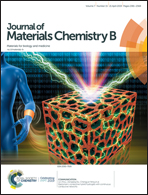Melamine-promoted formation of bright and stable DNA–silver nanoclusters and their antimicrobial properties†
Abstract
A new method has been developed for the preparation of brightly fluorescent and stable DNA–silver nanoclusters (DNA–AgNCs). The approach takes advantage of specific interactions occurring between melamine and thymine residues in a DNA template. These interactions cause the formation of a melamine–DNA–AgNC complex (Mel–DNA–AgNCs), in which a change in the environment of the DNA template causes binding of additional Ag+ and an enhancement in the fluorescence efficiency and stability. The effects of the nature of the template DNA, DNA : Ag+ : NaBH4 ratio, pH and temperature were systematically assessed in order to maximize the melamine-promoted fluorescence enhancement. The results show that the Mel–DNA–AgNCs, generated under the optimal conditions, exhibit a ca. 3-fold larger fluorescence efficiency and long-term stability (70 d) in contrast to those of DNA–AgNCs in the absence of melamine. Importantly, the bright and stable Mel–DNA–AgNCs exhibit antimicrobial activities against Gram-positive and Gram-negative bacteria that are superior to those of DNA–AgNCs alone. To the best of our knowledge, this is the first report describing the synthesis of DNA–AgNCs that have improved fluorescence efficiencies and that function as effective antimicrobial agents.



 Please wait while we load your content...
Please wait while we load your content...